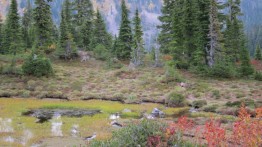Months of warning signs from Mauna Loa, on Hawaii’s Big Island, prompted the U.S. Geological Survey to recently start releasing weekly updates on activity at the world’s largest active volcano. For now, such warning signs can only rely on external clues, like earthquakes and gas emissions. But a University of Washington simulation has managed to demonstrate what’s happening deep inside the volcano.
Read more at UW Today »Natural Hazards and Resilient Communities: Q&A with UW's David Montgomery
UW’s David R. Montgomery, professor of Earth & Space Sciences, knows there’s more to our planet’s surface than what’s at surface level. The geomorphologist studies the ground beneath our feet; both its propensity to shift and evolve and how those processes might affect ecological systems and human societies past and present.
Read more »Scientists: Let wildfires burn when prudent
With nearly 9 million acres burned this year across the nation, 2015 is shaping up to be one of the most destructive wildfire seasons yet. And with drought and climate change, wildfires are only predicted to get worse. In a commentary published Sept. 17 in Science, a team of scientists, including School of Environmental and Forest Sciences‘ researchers Jerry Franklin and James Agee, describe unique opportunities and provide suggestions to reform forest fire management to reduce the impacts of inevitable wildfires in future years.
Read more at UW Today »Seattle Times lauds UW's Climate Impacts Group and Arctic studies program
In a piece published by The Seattle Times, the editorial board calls for the United States to get out from behind the curve in addressing emerging challenges and opportunities in the Arctic. They call for comprehensive policies that will position the U.S. to capitalize on the upcoming changes — many of which are already here — and cite the University of Washington’s new Arctic Studies Program and the Climate Impacts Group as leaders in the kind of interdisciplinary thinking and approach it will take to be successful.
Read more at The Seattle Times »Climate change could leave Pacific Northwest amphibians high and dry
Far above the wildfires raging in Washington’s forests, a less noticeable consequence of this dry year is taking place in mountain ponds. The minimal snowpack and long summer drought that have left the Pacific Northwest lowlands parched have also affected the region’s amphibians through loss of mountain pond habitat. According to a new paper published Sept. 2 in the open-access journal PLOS ONE, this summer’s severe conditions may be the new normal within just a few decades.
Read more at UW Today »





